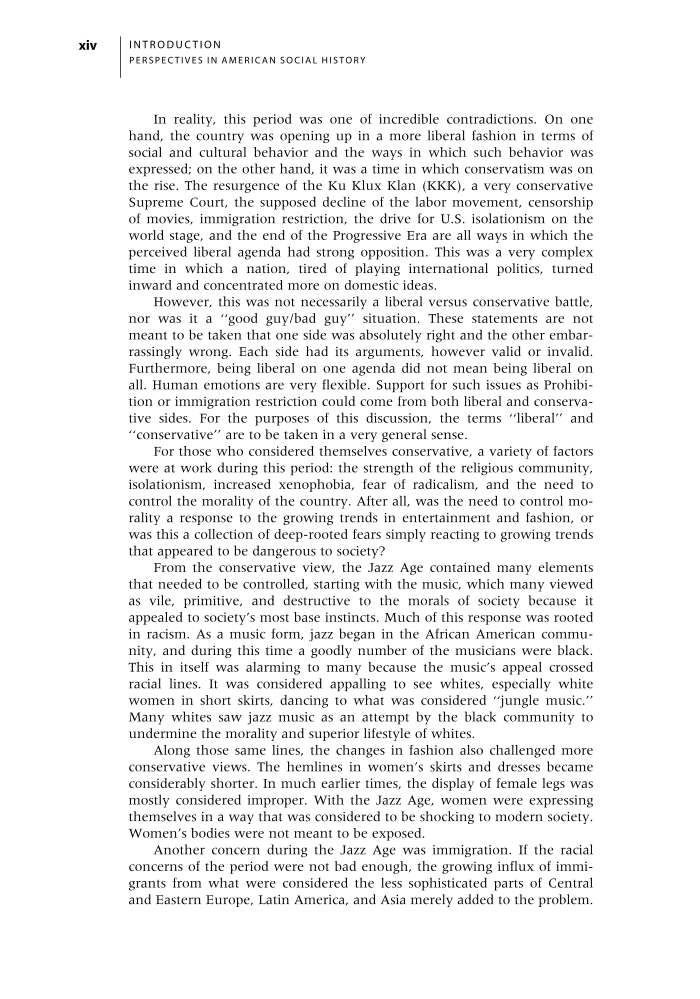In reality, this period was one of incredible contradictions. On one hand, the country was opening up in a more liberal fashion in terms of social and cultural behavior and the ways in which such behavior was expressed on the other hand, it was a time in which conservatism was on the rise. The resurgence of the Ku Klux Klan (KKK), a very conservative Supreme Court, the supposed decline of the labor movement, censorship of movies, immigration restriction, the drive for U.S. isolationism on the world stage, and the end of the Progressive Era are all ways in which the perceived liberal agenda had strong opposition. This was a very complex time in which a nation, tired of playing international politics, turned inward and concentrated more on domestic ideas. However, this was not necessarily a liberal versus conservative battle, nor was it a ‘‘good guy/bad guy’’ situation. These statements are not meant to be taken that one side was absolutely right and the other embar- rassingly wrong. Each side had its arguments, however valid or invalid. Furthermore, being liberal on one agenda did not mean being liberal on all. Human emotions are very flexible. Support for such issues as Prohibi- tion or immigration restriction could come from both liberal and conserva- tive sides. For the purposes of this discussion, the terms ‘‘liberal’’ and ‘‘conservative’’ are to be taken in a very general sense. For those who considered themselves conservative, a variety of factors were at work during this period: the strength of the religious community, isolationism, increased xenophobia, fear of radicalism, and the need to control the morality of the country. After all, was the need to control mo- rality a response to the growing trends in entertainment and fashion, or was this a collection of deep-rooted fears simply reacting to growing trends that appeared to be dangerous to society? From the conservative view, the Jazz Age contained many elements that needed to be controlled, starting with the music, which many viewed as vile, primitive, and destructive to the morals of society because it appealed to society’s most base instincts. Much of this response was rooted in racism. As a music form, jazz began in the African American commu- nity, and during this time a goodly number of the musicians were black. This in itself was alarming to many because the music’s appeal crossed racial lines. It was considered appalling to see whites, especially white women in short skirts, dancing to what was considered ‘‘jungle music.’’ Many whites saw jazz music as an attempt by the black community to undermine the morality and superior lifestyle of whites. Along those same lines, the changes in fashion also challenged more conservative views. The hemlines in women’s skirts and dresses became considerably shorter. In much earlier times, the display of female legs was mostly considered improper. With the Jazz Age, women were expressing themselves in a way that was considered to be shocking to modern society. Women’s bodies were not meant to be exposed. Another concern during the Jazz Age was immigration. If the racial concerns of the period were not bad enough, the growing influx of immi- grants from what were considered the less sophisticated parts of Central and Eastern Europe, Latin America, and Asia merely added to the problem. xiv I N T R O D U C T I O N P E R S P E C T I V E S I N A M E R I C A N S O C I A L H I S T O R Y
Document Details My Account Print multiple pages
Print
You have printed 0 times in the last 24 hours.
Your print count will reset on at .
You may print 0 more time(s) before then.
You may print a maximum of 0 pages at a time.









































































































































































































































































































